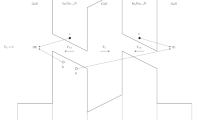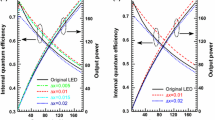Abstract
Light emission charactersitcs of single and coupled wurtzite (WZ) InGaN/GaN quantum-dot (QD) structures were investigated by using an effective mass theory. Strain components in the well of the coupled QD are found to be smaller than those in the well of the single QD structure. In particular, the reduction effect in ϵzz is dominant and, as a result, the polarization component Izz for the strain tensor ϵzz is largely reduced for the coupled QD. The coupled QD structure shows much larger peak intensity than the single QD structure because the interband transition probability between electrons and holes is enhanced owing to the reduced internal field.
Similar content being viewed by others
References
D. Bimberg, M. Grundmann and N. N. Ledentsov: Quantum Dot Heterostructure (Wiley, New York, 1999), Ch. 1.
J. Piprek (ed.), Handbook of Optoelectronic Device Modeling and Simulation, (CRC Press, Boca Raton, 2017), Chs. 11 and 13.
J. J. Wierer, Jr., N. Tansu, A. J. Fischer and J. Y. Tsao, Laser Photonics Rev. 10, 612 (2016).
Y-R. Wu, Y-Y. Lin, H-H. Huang and J. Singh, J. Appl. Phys. 105, 013117 (2009).
O. G. Schmidt et al., Electron. Lett. 32, 1302 (1996).
N. N. Ledentsov et al., Appl. Phys. Lett. 70, 2888 (1997).
S. Schulz, A. Berube and E. P. O’Reilly, Phys. Rev. B 79, 081401(R) (2009).
S. Schulz and E. P. O’Reilly, Phys. Rev. B 82, 033411 (2010).
A. Neogi et al., Nano Lett. 5, 213 (2004).
S. C. Davies, D. J. Mowbray, F. Ranalli and T. Wang, Appl. Phys. Lett. 96, 251904 (2010).
S. L. Chuang, IEEE J. Quantum Electron. 32, 1791 (1996).
S. H. Park and S. L. Chuang, Phys. Rev. B 59, 4725 (1999).
E. O. Kane, J. Phys. Chem. Solids 1, 249 (1957).
S. S. Huang et al., Chin. Phys. B 17, 323 (2008).
S. Schulz, A. Berube and E. P. O’Reilly, Phys. Rev. B 79, 081401(R) (2009).
Acknowledgments
This research was supported by the Basic Science Research Program through the National Research Foundation of Korea (NRF) funded by the Ministry of Education, Science and Technology (2018R1D1A1B07042028).
Author information
Authors and Affiliations
Corresponding author
Rights and permissions
About this article
Cite this article
Park, SH., Ahn, D. Effect of Coupled Quantum-Dot Insertion on the Radiative Recombination Probability of Wurtzite InGaN/GaN Quantum Dots. J. Korean Phys. Soc. 76, 55–58 (2020). https://doi.org/10.3938/jkps.76.55
Received:
Revised:
Accepted:
Published:
Issue Date:
DOI: https://doi.org/10.3938/jkps.76.55




